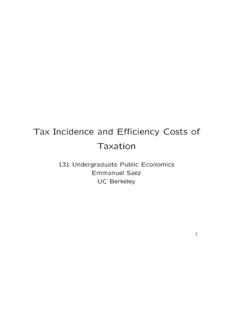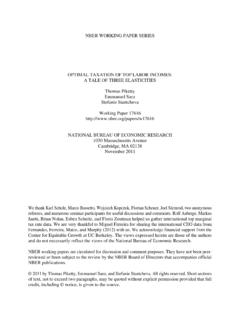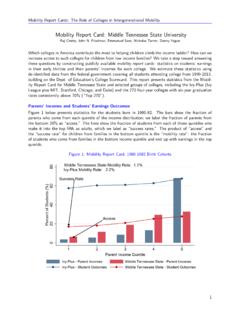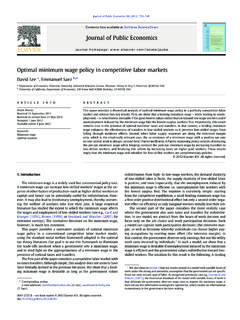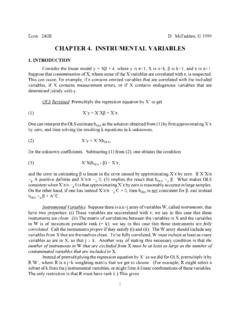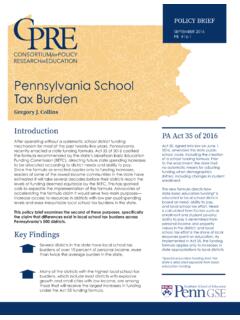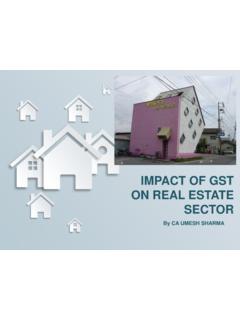Transcription of Incidence and Distribution - Econometrics Laboratory, UC ...
1 Incidence and DistributionTheory of Tax IncidenceThere are four principles in the analysis of tax Incidence :1. The entire burden of a tax must be traced to individuals. Businessesmay remit taxes, but only individuals shareholders, employees, customers canbear the burden of The ultimate Distribution of the tax burden may di er from the statu-tory liability; that is, the tax burden may be shifted because prices The long run e ect of taxes does not usually depend on which side ofthe market the statutory liability is The better the alternatives one has to the taxed good or activity, theless likely one is to bear the burden of the analysis so far has assumed a single homogenous type of labor and a xedpre-tax wage.
2 If there are two types of labor, skilled and unskilled, increasing thetax on skilled labor may decreased the supply of that labor, thereby increasingthe pre-tax wage. Similarly, a tax on capital income may encourage capital ight, decreasing productivity and the wage rate in the taxing country. Simplemodels also assume that the only thing consumers sell is their labor, ignoringthe fact that while an increase in the price of a good makes those who buy itworse o , it also makes those who produce it better o .The Incidence of a tax may shift because the tax causes prices to change inthe taxed market or in other markets. A tax on yachts will increase the priceof yachts, causing fewer yachts to be bought.
3 The new, after-tax price is notnecessarily equal to the old price, so that the burden of the tax falls not juston those who buy yachts, but also those who produce them. A tax on butterwill cause substitution toward margarine, driving up the price of buyers are worse o and margarine producers are better o eventhough the tax was imposed in a di erent liability can a ect Incidence in some situations. Statutory liabilitycan also a ect the e ciency of the tax system. Employers may have an advan-tage in record-keeping because of economies of scale, so having employers remitthe taxes means a lower cost for collecting given revenue. If evasion opportu-nities di er based on who remits the taxes, changes in statutory liability cana ect Incidence .
4 With noncompetitive behavior, ad valorem and unit taxes donot have the same e ect. Ad valorem taxes lower prices and increase quantitymore than unit run Incidence may vary because of long run variations in the elasticityof supply and demand. In Figure 19a, the consumer price rises considerably,while there is little change to the producer price. The consumer has no goodalternative to the taxed good ( , demand is relatively inelastic) so the con-sumer bears the majority of the burden of the tax. Contrast this with Figure19b, where there is elastic demand and inelastic supply. In this case, the con-sumer price rises relatively little, while the producer price falls more, so theproducer bears most of the burden of the tax.
5 Consider as a concrete examplehow the Incidence of a tax varies when comparing a tax on food, hamburgers,and McDonald s hamburgers. The demand for food is relatively inelastic, so theburden of such a tax will fall mainly on consumers. The demand for hamburgersis much more elastic since people can switch to hot dogs or other substitutes; atax in this market will not have much e ect on the consumer price. The demandfor McDonald s hamburgers, if Burger King s are a perfect substitute, is fullyelastic; the burden of a tax will be borne by the producer. As a general rule,for one market, the ratio of supply and demand elasticities will determine theincidence of a that Incidence analysis does not require using the compensated demandcurve, because it addresses the question of who bears the entire burden of a tax,not just the excess can analyze the labor market just as we would the market for any othercommodity.
6 Labor supply is determined by an individual s preferences betweenlabor and leisure. Labor demand depends on technology and the ability tosubstitute between capital and labor. If there is high substitutability between2capital and labor, labor demand will be very elastic and workers will bear mostof the burden of a tax in the form of a lower after-tax wage. If labor supply isvery inelastic, workers will also bear the burden of a tax. If a tax was imposedjust on those who work at McDonald s, the high elasticity of labor supply for thisone employer implies that McDonald s will have to pay higher pre-tax at McDonald s will not bear the burden ; to discover the Incidence of thetax we would have to trace its e ects through the corporation, to shareholdersor customers.
7 When there is more than one type of labor, the Incidence of a taxon one type will depend on the substitutability between the two , studies show that the uncompensated elasticity of labor supplyis very small or zero for the core labor force. Those with low labor force attach-ment, such as teenagers, married women, and the nearly retired, have a higherelasticity. If there are responses to the income tax not on the labor/leisure mar-gin, labor supply elasticity is less important for Incidence than the elasticity oftotal taxable income. However, if we are concerned with the e ect of taxes onthe wage rate, the labor supply elasticity is still mentioned brie y above, a tax on one good may a ect the markets forother goods as well.
8 Thus, we need to consider Incidence in general equilibrium,particularly when very close substitutes to a taxed good exist. A tax on butterwill raise the consumer price and reduce the producer price of butter. In Figure20a, this is shown as a reduction in the supply of butter. (It could also berepresented as a decrease in demand). Given the assumptions about elasticitiesimplied by the slope of the curves, there are declines in both consumer andproducer surplus; both bear some of the burden of the tax. The rise in theconsumer price of butter will cause some consumers to switch to margarine,which is a shift out in the demand curve in Figure 20b. Area B in this gure isalso a change in consumer surplus.
9 The e ects of the tax in this market, however,are zero-sum. The fall in consumer surplus for purchasers of margarine is exactlyo set by the rise in producer surplus for those who sell that margarine. The taxdoes not create a wedge of deadweight loss in this market; it simply redistributessurplus. The full burden of the tax, both the revenue raised and the deadweightloss, can be measured in the primary market for full general equilibrium analysis will look at the burden that falls on pro-ducers and trace it back to the individuals that actually bear that burden byanalyzing the markets for factor inputs. To consider who bears the burdenof a tax on wine, for example, we will have to look at what happens to winedrinkers, vineyard owners, and vineyard employees.
10 Figure 21 shows three mar-kets, for wine, vineyard employees, and vineyard land. Drawing conclusionsabout Incidence will require making some assumptions about the structure ofthese markets. As drawn, the market for wine has standard demand and supplycurves. Since vineyard employees can move to other industries, at least in thelong run, the supply of workers is at. If we assume that vineyards can only beused in producing grapes, the supply of land for grapes will be are the e ects of a tax on wine? The price of wine will rise, decreasingthe amount of wine supplied (shown in Figure 21a as a shift back of the supplycurve). Since less wine is being produced, the demand for workers and land inthis industry falls.
